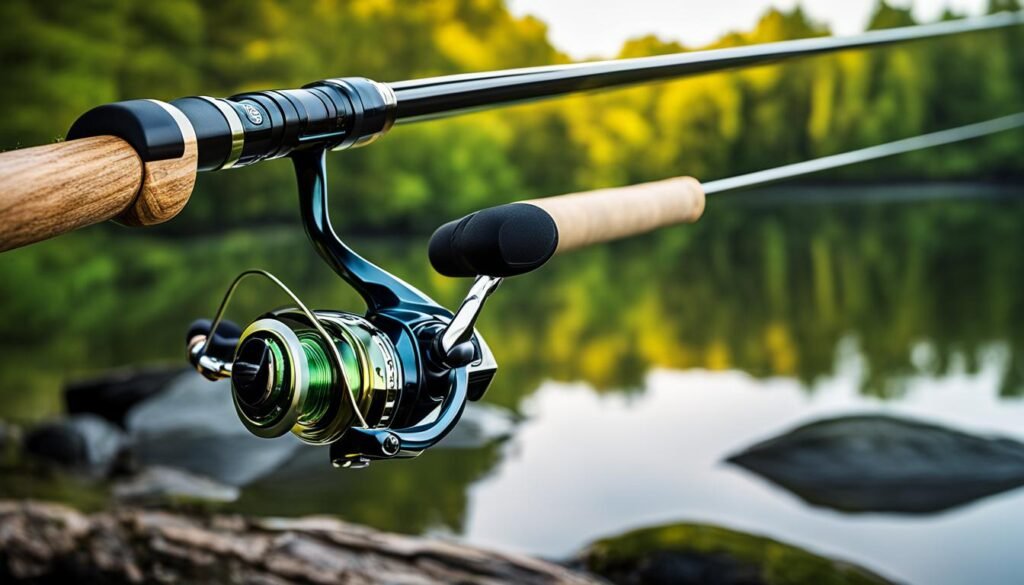Bass fishing is an exciting and rewarding activity that requires the right gear and accessories to enhance your fishing experience. Whether you’re a seasoned angler or just starting out, having the essential bass accessories in your tackle box is crucial for success.
In this article, we will guide you through the must-have accessories for successful bass fishing. From rods and reels to hooks, lures, and lines, we will cover everything you need to know to equip yourself for a productive day on the water.
So, let’s dive in and explore the world of essential bass fishing accessories that will take your angling skills to the next level!
The Ultimate Rod and Reel Setup for Bass Angling Mastery
Choosing the right rod and reel setup is essential for mastering bass fishing. Your choice of rod and reel will greatly impact your fishing style and techniques, as well as the overall performance and success of your angling endeavors.
Choosing the Right Rod: Length, Action, and Power
When it comes to selecting the perfect rod for bass fishing, several factors need to be considered. Firstly, the length of the rod plays a crucial role in determining casting distance and control. Longer rods are ideal for making longer casts, while shorter rods offer better accuracy for precise casts.
The action of the rod refers to its flexibility and how it responds when pressure is applied. Fast-action rods provide a quick response, making them ideal for techniques that require quick and powerful hooksets. On the other hand, medium or slow-action rods provide a more forgiving bend, making them suitable for techniques that require a more delicate presentation.
The power of the rod refers to its strength or lifting power. Light power rods are suitable for smaller baits and lighter lines, while heavy power rods can handle larger baits and heavier lines. It’s important to choose a rod power that matches the size of the bass you typically target and the fishing conditions you encounter.
Matching Your Reel with Your Rod for Optimum Performance
Once you have chosen the right rod, the next step is to find a reel that complements its performance. When matching a reel with your rod, consider factors such as line capacity, gear ratio, and the type of reel.
In bass fishing, a spinning reel or a baitcasting reel is commonly used. Spinning reels are versatile and easier to use, making them a popular choice for beginners and anglers who prefer finesse techniques. Baitcasting reels, on the other hand, offer greater casting accuracy and control, making them ideal for power techniques and handling larger baits.
Ensure that the reel you choose has the appropriate line capacity to accommodate the line weight and length that you plan to use. The gear ratio of the reel determines how quickly the line is retrieved, with higher gear ratios providing faster retrieval speeds.
Top Picks: Shimano Spinning Rod and Abu Garcia Cardinal SX30 Reel
When it comes to top-quality rod and reel combinations for bass fishing, two brands stand out: Shimano and Abu Garcia.
Shimano is known for its exceptional spinning rods that offer unmatched performance and durability. Their rods are designed with precision and engineering excellence to provide maximum sensitivity and responsiveness, allowing you to feel even the slightest nibble from a bass.
One highly recommended Shimano spinning rod is the Shimano SLX Spinning Rod, available in a variety of lengths and power options to suit different fishing styles. It features a strong and lightweight construction, making it comfortable to use for long fishing sessions.
When it comes to reels, the Abu Garcia Cardinal SX30 stands out as an excellent choice for bass fishing. This spinning reel offers smooth and reliable performance, thanks to its precision-engineered components and high-quality construction. It features a lightweight yet durable design, making it perfect for casting and retrieving bass lures with ease.
Together, the Shimano SLX Spinning Rod and Abu Garcia Cardinal SX30 Reel create the ultimate rod and reel setup for bass angling mastery. With their exceptional performance, these two fishing tools will enhance your experience on the water and increase your chances of success in landing that trophy bass.
Navigating Hooks, Weights, and Terminal Tackle Essentials
When it comes to bass fishing, having the right hooks, weights, and terminal tackle is essential for a successful angling experience. These tools are the key to effectively presenting your baits and lures to the bass and increasing your chances of a hookup. In this section, we will explore the different types of hooks, the importance of selecting the right weights, and the essential terminal tackle items every bass angler needs.
Types of Hooks for Bass Fishing
There are various types of hooks available for bass fishing, each designed for different applications and fishing techniques. Some commonly used hooks include:
- Offset Worm Hooks: Best for rigging plastic worms and other soft plastics.
- Wide Gap Hooks: Ideal for fishing with bulky baits and lures.
- Drop Shot Hooks: Specifically designed for drop shot rigs.
- Swim Bait Hooks: Perfect for fishing with swimbaits.
Each hook type has its own unique features and benefits, allowing you to tailor your presentation to the specific fishing conditions and the behavior of the bass.
Selecting the Right Weights
Choosing the right weights is crucial in bass fishing as they determine how your bait or lure will behave in the water. Here are some factors to consider when selecting weights:
- Water Depth: Use heavier weights for deeper waters to ensure your bait reaches the desired depth.
- Bait Type: Match the weight of your bait or lure to achieve the desired action and presentation.
- Fishing Technique: Different techniques, such as flipping or pitching, may require specific weights for optimal performance.
By selecting the right weights, you can effectively control the movement and position of your bait, increasing your chances of enticing the bass to strike.
Essential Terminal Tackle
In addition to hooks and weights, having the right terminal tackle items in your tackle box is crucial for creating effective rigs. Here are some essential terminal tackle items for bass fishing:
- Swivels: Used to prevent line twist and provide free movement of your bait or lure.
- Split Rings: Connect your hooks or lures to your fishing line and provide flexibility and improved action.
- Leader Material: Strong and durable material used to connect your main line to your bait or lure.
These terminal tackle items enable you to create versatile and effective rigs that will increase your chances of success on the water.
With the right hooks, weights, and terminal tackle in your tackle box, you’ll be well-equipped to navigate the world of bass fishing. These tools will help you present your baits and lures effectively and increase your chances of landing that trophy bass. So, make sure to stock up on the necessary hooks, weights, and terminal tackle before your next bass fishing adventure.
Soft Plastic Baits: Secret Weapons for Bass

When it comes to attracting bass, soft plastic baits are considered secret weapons by experienced anglers. These versatile lures have been proven to entice even the most finicky bass into striking. What makes them so effective? Let’s dive into the details.
Why Green Pumpkin is the Color of Choice for Bass Lures
One of the best colors for bass lures is green pumpkin. This earthy shade, resembling a pumpkin or watermelon, is highly effective in various water conditions. It provides a natural presentation that mimics the bass’s prey, making it irresistible to them. Whether in clear or murky waters, green pumpkin lures excel in attracting hungry bass.
The Versatility of the Yamamoto Senko & Reaction Innovations Sweet Beaver
Two popular soft plastic baits that every bass angler should have in their tackle box are the Yamamoto Senko and the Reaction Innovations Sweet Beaver. These lures are known for their versatility and ability to trigger bass strikes in various fishing scenarios.
The Yamamoto Senko is a legendary bait considered by many as the ultimate bass magnet. Its simple design and subtle action make it a deadly weapon for both beginners and seasoned anglers. Whether rigged weightless or with a weight, the Yamamoto Senko’s tantalizing fall and lifelike flutter drive bass wild.
Another exceptional soft plastic bait is the Reaction Innovations Sweet Beaver. This beaver-style bait excels in dense cover and heavy vegetation. Its unique action and realistic profile fool even the most cautious bass. With its multiple appendages and enticing kicking motion, the Sweet Beaver is hard for bass to resist.
Rigging Techniques for Soft Plastics: Texas, Carolina, and Drop Shot
To maximize the effectiveness of soft plastic baits, it’s essential to learn various rigging techniques. Three popular methods are the Texas rig, Carolina rig, and drop shot rig.
The Texas rig is a versatile setup that works well in heavy cover. By inserting a weighted bullet sinker into the bait and using an offset hook, the Texas rig offers weedless presentation and increased hook-setting capabilities.
The Carolina rig is perfect for covering large areas and searching for bass. It involves placing a bullet-shaped weight on the mainline above a swivel, creating a separation between the weight and the bait. This rig allows the soft plastic bait to move freely, enticing bass over a wide area.
The drop shot rig is a finesse technique mainly used in clear or highly pressured waters. It involves attaching a small weight at the end of the line, with the soft plastic bait suspended above it using a special hook. The drop shot rig excels in enticing inactive or hesitant bass into striking.
Mastering these rigging techniques will give you the confidence and knowledge to adapt to different fishing conditions and increase your chances of landing more bass.
Bass Accessories: Selecting Quality Lines for Success
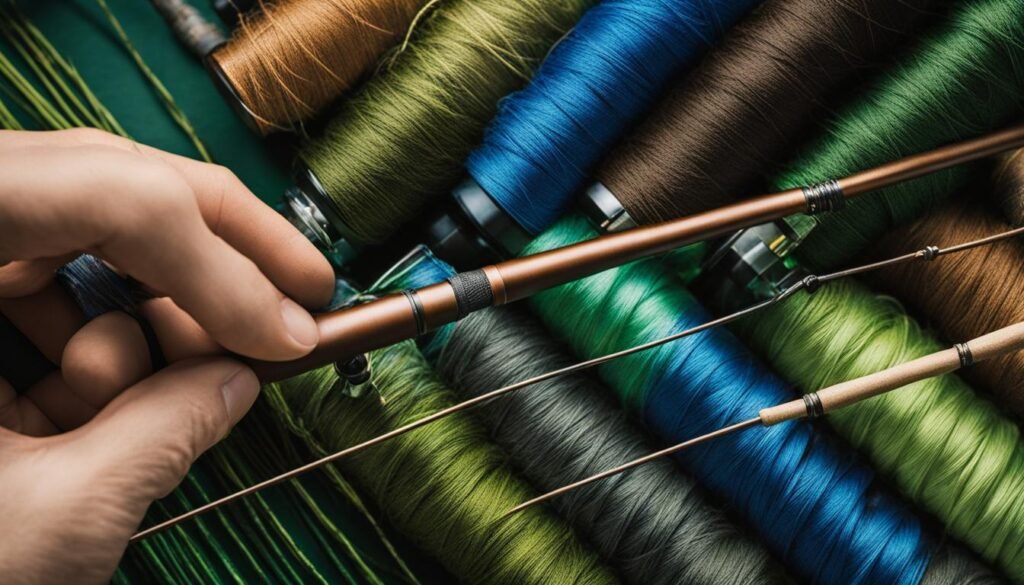
Selecting the right fishing line is crucial for a successful bass fishing experience. The type of line you choose can significantly impact your chances of landing that trophy bass. In this section, we will explore the different types of bass fishing lines, discuss their advantages, and help you make an informed decision when selecting the best line for your needs.
The Visibility Advantage with Fluorocarbon Lines
Fluorocarbon lines offer a visibility advantage that can make a difference in enticing bass to bite. These lines are made from a dense material that effectively transmits light, making them virtually invisible underwater. Their low visibility can be a game-changer when targeting wary and cautious bass. With fluorocarbon lines, you can present your bait more naturally and increase your chances of getting a strike.
Braided vs. Monofilament: What’s Best for Bass?
When it comes to choosing between braided and monofilament lines for bass fishing, there are several factors to consider. Braided lines are known for their exceptional strength and sensitivity, making them suitable for heavy cover and long-distance casting. On the other hand, monofilament lines offer more stretch and can provide a shock-absorbing effect, which can be advantageous when fighting aggressive and hard-hitting bass.
Understanding Line Strength: Selecting the Proper Pound Test
Line strength plays a crucial role in successfully landing bass. It is important to select the proper pound test based on the size and fighting power of the bass you are targeting. Lighter lines in the 8-12 lb range are ideal for finesse fishing and targeting smaller bass, while heavier lines in the 14-20 lb range are better suited for handling larger and more aggressive bass. Understanding line strength will ensure you have the appropriate strength to handle the fight and land your catch.
As you can see, selecting the right fishing line is essential for bass fishing success. Consider the visibility advantage of fluorocarbon lines, compare braided and monofilament lines based on your fishing style, and understand the importance of line strength when selecting the proper pound test. By choosing the right line, you will increase your chances of hooking that trophy bass and making every fishing trip a memorable one.
Spinnerbaits and Crankbaits: Essential Additions to Your Tackle Box
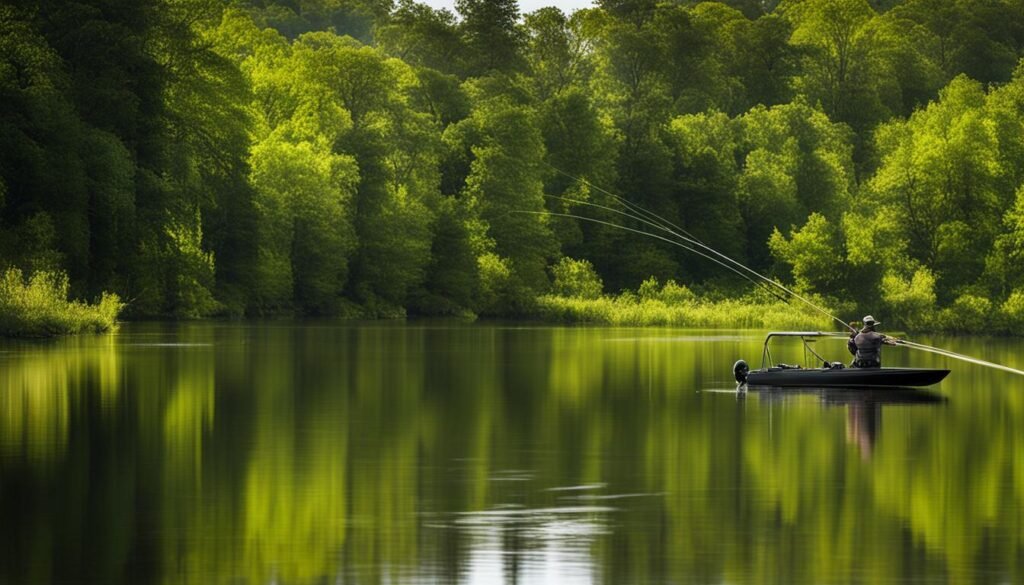
Spinnerbaits and crankbaits are essential lures that every bass angler should have in their tackle box. These versatile and effective lures are designed to mimic the movement of baitfish, making them irresistible to bass. Whether you’re fishing in shallow water or targeting deep structures, spinnerbaits and crankbaits can help you land more bass.
Picking the Right Spinnerbait: Color and Blade Combinations
When selecting a spinnerbait, consider the color and blade combinations that will attract bass in your fishing area. Bright and vibrant colors like chartreuse, white, and firetiger are popular choices. Additionally, choosing spinnerbaits with different blade combinations, such as willow leaf, Colorado, or Indiana blades, allows you to experiment and find what works best in different water conditions.
Diving into Success: Choosing Your Crankbaits for Various Depths
Crankbaits are designed to dive to specific depths, making them great for targeting bass at different levels in the water column. Shallow-diving crankbaits are ideal for fishing in shallow waters or near the surface, while medium-diving and deep-diving crankbaits are effective for exploring deeper structures. Consider the diving depth, size, and color of the crankbait to match the target depth and the prey fish species in the area.
Case Studies: Successful Catches with Strike King Spinnerbaits and Megabass Crankbaits
To illustrate the effectiveness of spinnerbaits and crankbaits, let’s take a look at two popular brands: Strike King and Megabass. Strike King spinnerbaits are known for their realistic designs, vibrant colors, and durable construction. Anglers have experienced great success with their Premier Plus and Mini-King spinnerbaits. On the other hand, Megabass crankbaits, such as the Megabass Vision Oneten and the Megabass Deep-X, are renowned for their lifelike swimming action and high-quality finishes. Many anglers have landed trophy bass using these top-of-the-line crankbaits.
By including spinnerbaits and crankbaits in your tackle box and experimenting with different color combinations, blade types, and diving depths, you can increase your chances of success and enjoy a thrilling bass fishing experience.
Tools of the Trade: Pliers, Scales, and Scissors

Having the right tools is essential for a smooth and efficient bass fishing experience. When it comes to bass fishing, you need to be well-equipped with the necessary tools to handle various situations that may arise. Let’s take a closer look at some of the essential bass fishing tools that every angler should have in their tackle box:
Fishing Pliers
Fishing pliers are a versatile tool that comes in handy for a variety of tasks. From removing hooks to crimping split shot weights, these pliers are designed to provide a strong grip and make tasks easier. Whether you need to handle treble hooks or cut through stubborn fishing lines, fishing pliers are a must-have accessory for any bass angler.
Fish Scales
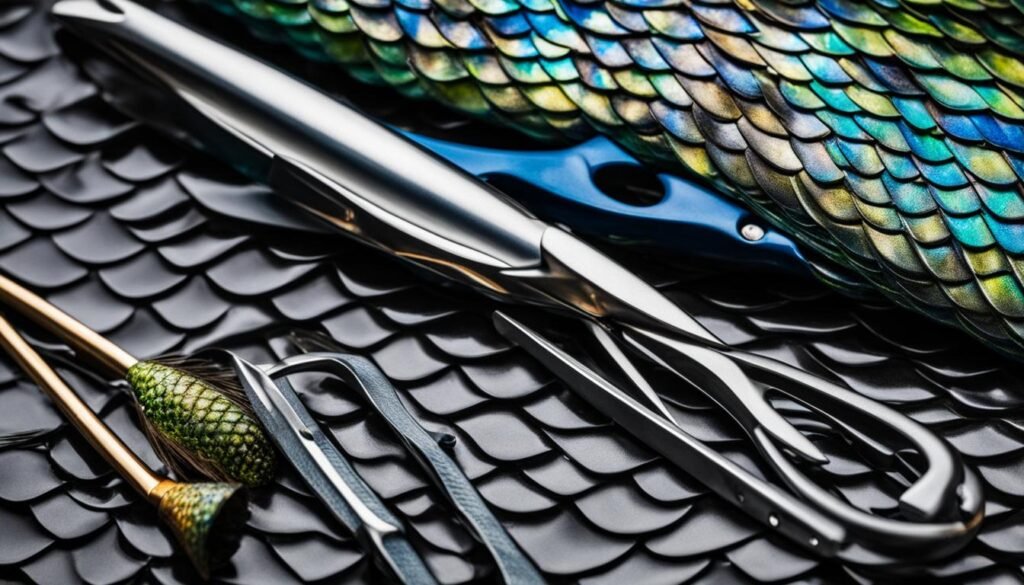
Knowing the weight of your catch is important for bragging rights and adhering to fishing regulations. Fish scales allow you to accurately weigh your bass, ensuring you have accurate measurements for record-keeping purposes. Look for fish scales that are lightweight, easy to use, and have a precise weighing mechanism to make your bass fishing experience more enjoyable.
Fishing Scissors
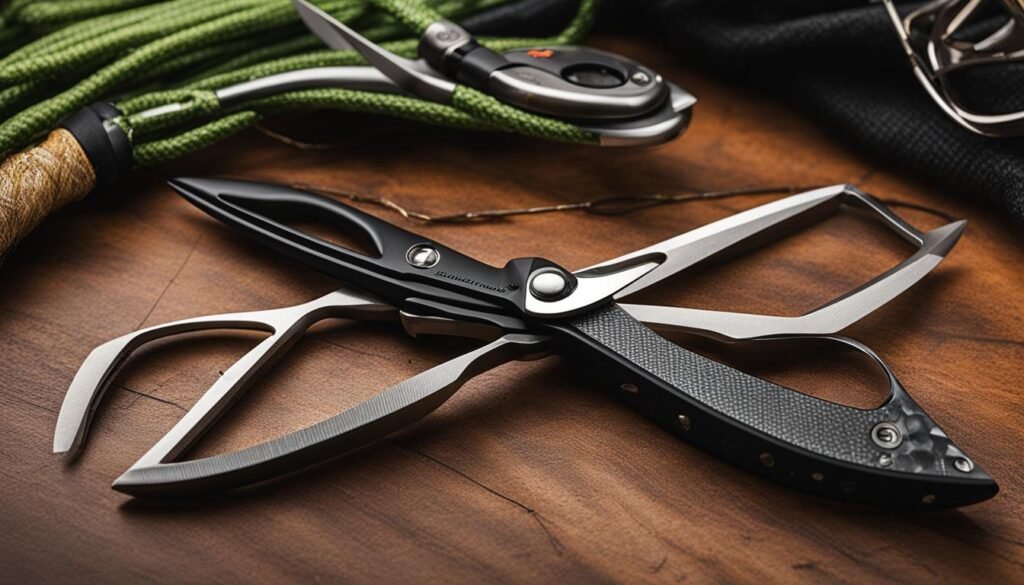
Fishing scissors are an essential tool for cutting fishing lines, trimming excess knots, and removing tangles. They are designed specifically for the fishing environment, with sharp blades that can easily cut through various fishing lines without fraying. Investing in a good pair of fishing scissors will save you time and frustration on the water.
With the right bass fishing tools such as fishing pliers, fish scales, and fishing scissors, you can handle your gear confidently and ensure the well-being of the fish. These essential tools will help enhance your bass fishing experience and make you a more efficient angler.
Maximizing Your Bass Strikes with Properly Selected Lures
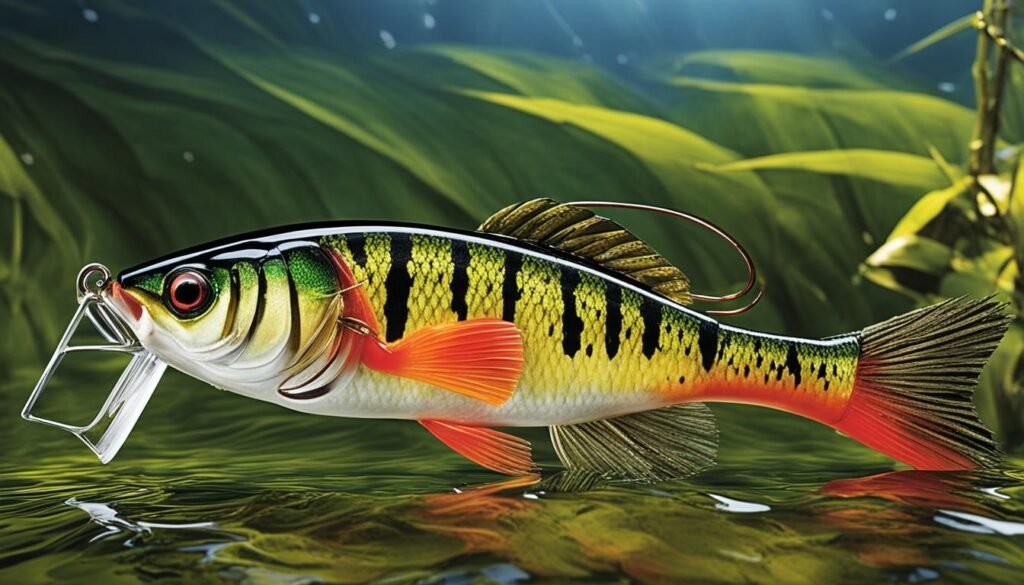
Selecting the right lures can significantly increase your chances of landing bass. By understanding the different types of lures and their effectiveness in specific situations, you can strategically choose the best options to maximize your bass strikes.
Stick Baits: A Top Choice for Anglers
Stick baits are a top choice for bass anglers due to their versatility and ability to mimic wounded baitfish. These long, slim lures have a lifelike action that entices bass into striking. Whether you choose a soft plastic stick bait or a hard plastic jerkbait, the realistic movement and natural appearance of these lures make them highly effective in various fishing conditions. Stick baits can be retrieved with a slow twitching motion or jerked aggressively to trigger reactionary strikes.
Finesse Worms and Jigs: For the Subtle Approach
Finesse worms and jigs offer a more subtle approach to bass fishing. Finesse worms, typically made of soft plastic, imitate small baitfish or worms, enticing bass with their lifelike appearance. These lures are commonly used in finesse fishing techniques such as drop shotting or shaky head rigging. Jigs, on the other hand, are versatile lures that can be used in various fishing techniques. Their skirted design and weedless hooks make them ideal for flipping and pitching into heavy cover, targeting bass hiding in vegetation or structure.
Lipless Crankbaits and Frogs: When Aggressive Action is Needed
Lipless crankbaits and frogs are excellent choices when a more aggressive action is needed to trigger bass strikes. Lipless crankbaits have a loud rattle and a vibrating action that mimics a fleeing baitfish. These lures are highly effective for covering large areas of water and attracting bass from a distance. Frogs, on the other hand, are designed to be fished on the water’s surface, imitating a frog swimming or hopping. The weedless design allows them to be retrieved over thick vegetation without snagging. Bass often strike frogs aggressively, making them an exciting choice for topwater fishing.
By incorporating these lures into your bass fishing arsenal, you can increase your chances of landing more bass and experiencing the thrill of a successful strike. Experiment with different techniques and lure presentations to find what works best for your fishing style and the conditions you’re facing on the water.
Exploring Topwater Techniques with Walking Baits and Frogs
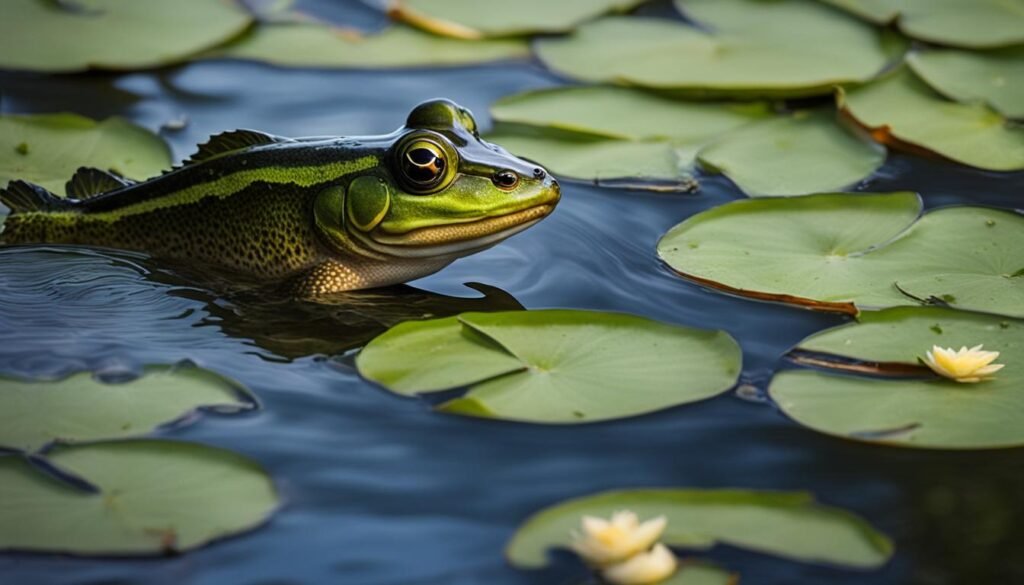
To enhance your bass fishing experience, it’s important to explore various techniques and lures. Topwater fishing can be both thrilling and productive when targeting bass. In this section, we will delve into the techniques involved in using walking baits and frogs for topwater bass fishing.
Walking baits are designed to imitate a struggling baitfish, creating a unique motion that entices bass to strike. These lures are typically retrieved in a side-to-side walking motion, causing a commotion on the water’s surface. Their erratic movement often triggers aggressive reactions from bass. Walking baits are great for covering large areas of water and attracting bass that are feeding near the surface.
Frogs, on the other hand, offer a weedless design that allows them to be worked through heavy cover and vegetation. This makes them an excellent choice for topwater fishing in areas with lily pads, grass, or lily ponds. By imitating a frog’s natural movements, these lures can fool bass into striking with explosive force. When using frogs, it’s important to cast them near vegetation or structure and work them with a popping or walking motion to mimic a frog’s natural behavior.
When employing topwater techniques with walking baits and frogs, keep in mind that bass often strike aggressively and can create an exhilarating experience. It’s essential to be patient and maintain a steady retrieve, allowing the fish enough time to fully engulf the lure before setting the hook.
By incorporating these topwater techniques into your bass fishing repertoire, you can increase your chances of landing a trophy-worthy catch. Experiment with different walking baits and frog designs, and adapt your approach based on the conditions and behavior of the bass in your fishing spot.
Preparing for Variable Bass Fishing Conditions
When it comes to bass fishing, it’s important to be prepared for the ever-changing conditions on the water. Whether you’re dealing with different seasons, weather patterns, or varying bodies of water, being adaptable is key to your success as an angler.
Seasonal Gear Adjustments: Adapting to Weather and Water Changes
As the seasons change, so do the habits and preferences of bass. It’s crucial to adjust your gear accordingly. For example, in colder months, bass tend to be more sluggish and may require slower presentations. This calls for using different lures and techniques compared to the warmer months when bass are more active. Additionally, you’ll need to take into account the water conditions, such as clarity and temperature, which can greatly impact bass behavior.
Bass Behavior: Understanding How Time and Temperature Affect Your Strategy
Time of day and water temperature play significant roles in bass behavior. Knowing when they are most active can help you plan your fishing trips accordingly. Early mornings and evenings are often prime feeding times, as bass are more active during low light conditions. As for water temperature, bass tend to be more active in certain temperature ranges. By understanding these patterns and adjusting your strategy, you can increase your chances of landing more bass.
Lake and River Tactics: How Geography Influences Your Accessory Choices
Lakes and rivers each come with their own unique characteristics that can greatly influence your bass fishing approach. For instance, lakes tend to provide more expansive fishing areas, allowing for different tactics such as using search baits to cover more water. Conversely, rivers often have stronger currents, requiring different lure presentations and techniques to navigate the flowing water. Understanding the geography of the water you’re fishing in will help you make the right accessory choices specific to each location.

